It was the long-awaited Boom! That shook the boating scene some weeks ago when market leader Beneteau announced the takeover of the Slovenian yard Seascape. The integration of the ex-Seascape boats into the product range of the French boatmaker made perfect sense: The old First 20 and 25 models are classics and pretty nice boats but fairly old concepts. The revival of the First-line and the strive to live up to old glories couldn´t have made better than by incorporating the young Adriatic start-up into the group.
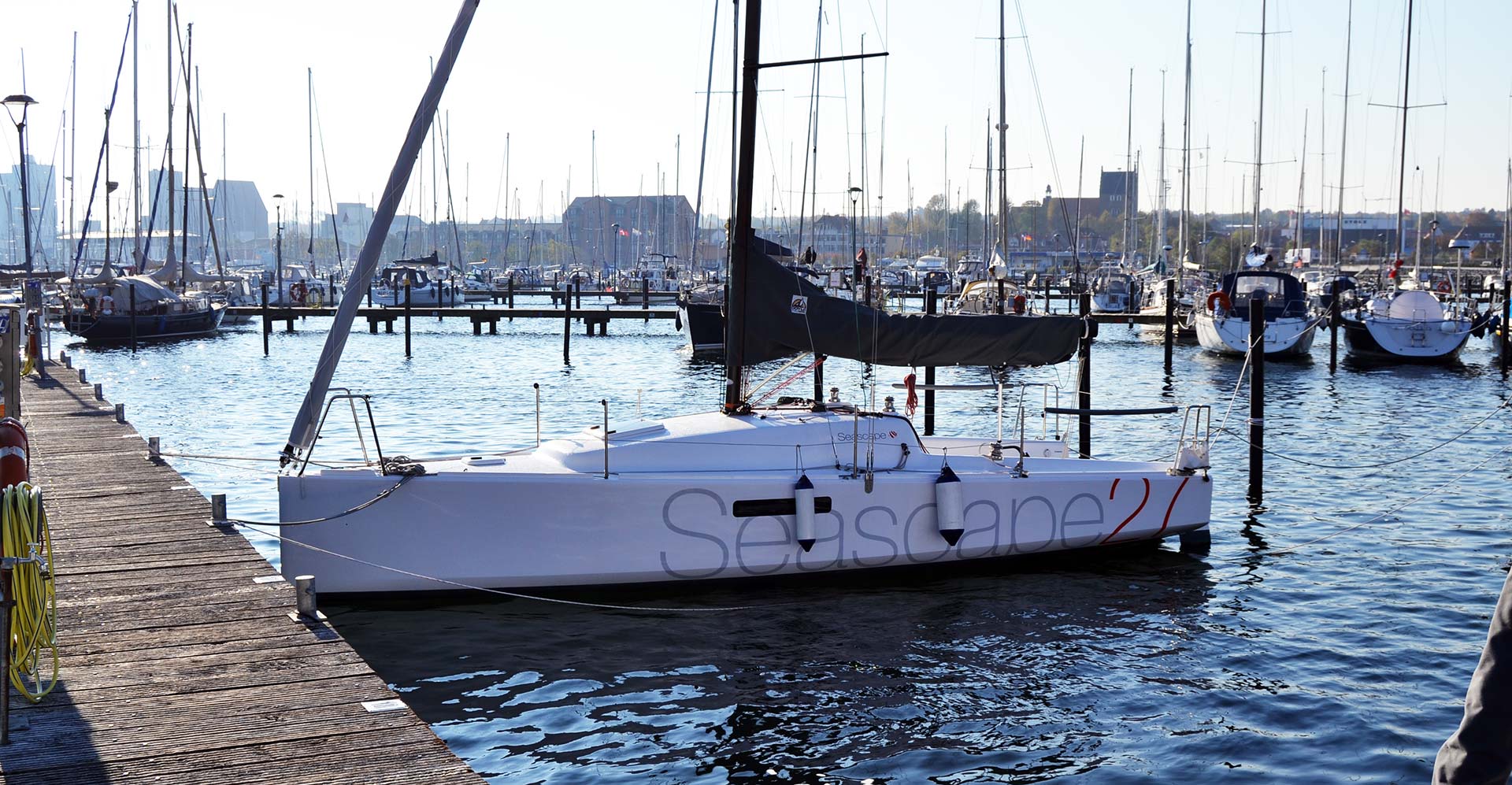
It may take a while to accommodate to the fact that these boats are now called “First” but we will get used to it. I did have the chance to speak to the Seascape guys during Cannes Yachting Festival and they too reassured me that they see a bright future for both their approach to sailing – as seen in the Seascape boats – and moreover for the boats which will follow. Right now there is a brand new 30-footer in the making. With that in mind I arranged a sea trial on the biggest available First/Seascape to date: The 27.
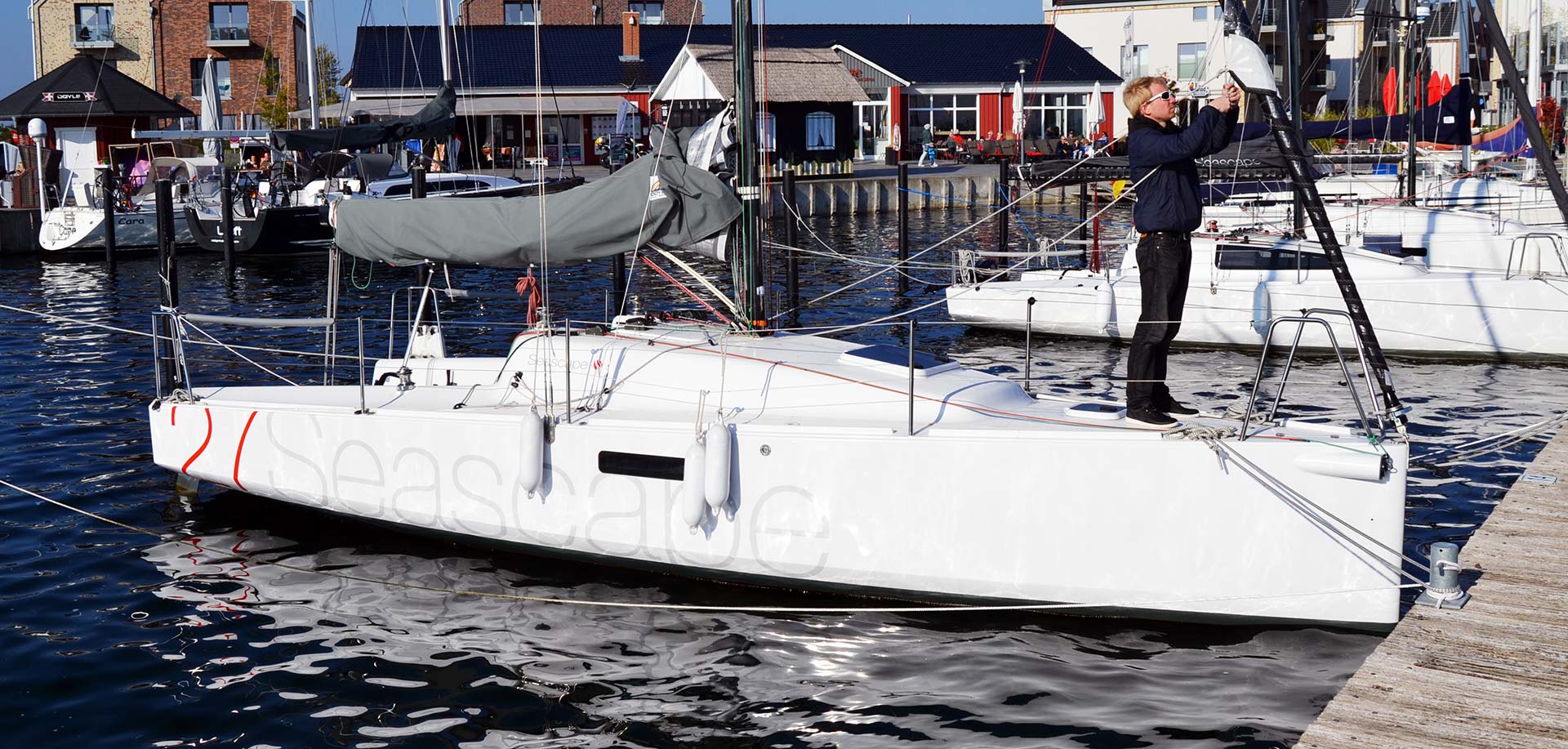
It was one of these perfect days: Bright clear sky, perfect sunshine and a steady nice wind of 10 to 14 knots true. I met Tim, a young sailor who is part of the O´Leu Doyler-sailmaker dynasty here at the Baltic shores and breathes sailing with every pore of his body. There she was, “our” boat for the day and I was very excited to finally get to experience by myself what it would be like to sail one of these magic Slovenian boats …
Inside the Beneteau First 27 a.k.a Seascape 27
Stepping aboard I rushed down below whilst Tim was taking off the tarp from the boom and prepared the boat. Utilizing the free time, I took a closer look at some of the interesting details of the Seascape/First 27 interior design. I liked the main switch panel which is conveniently placed right under the entry above the step of the companionway. Though there is not much to switch as the Seascape/First 27 really is a “no-frills” sailboat for sure!
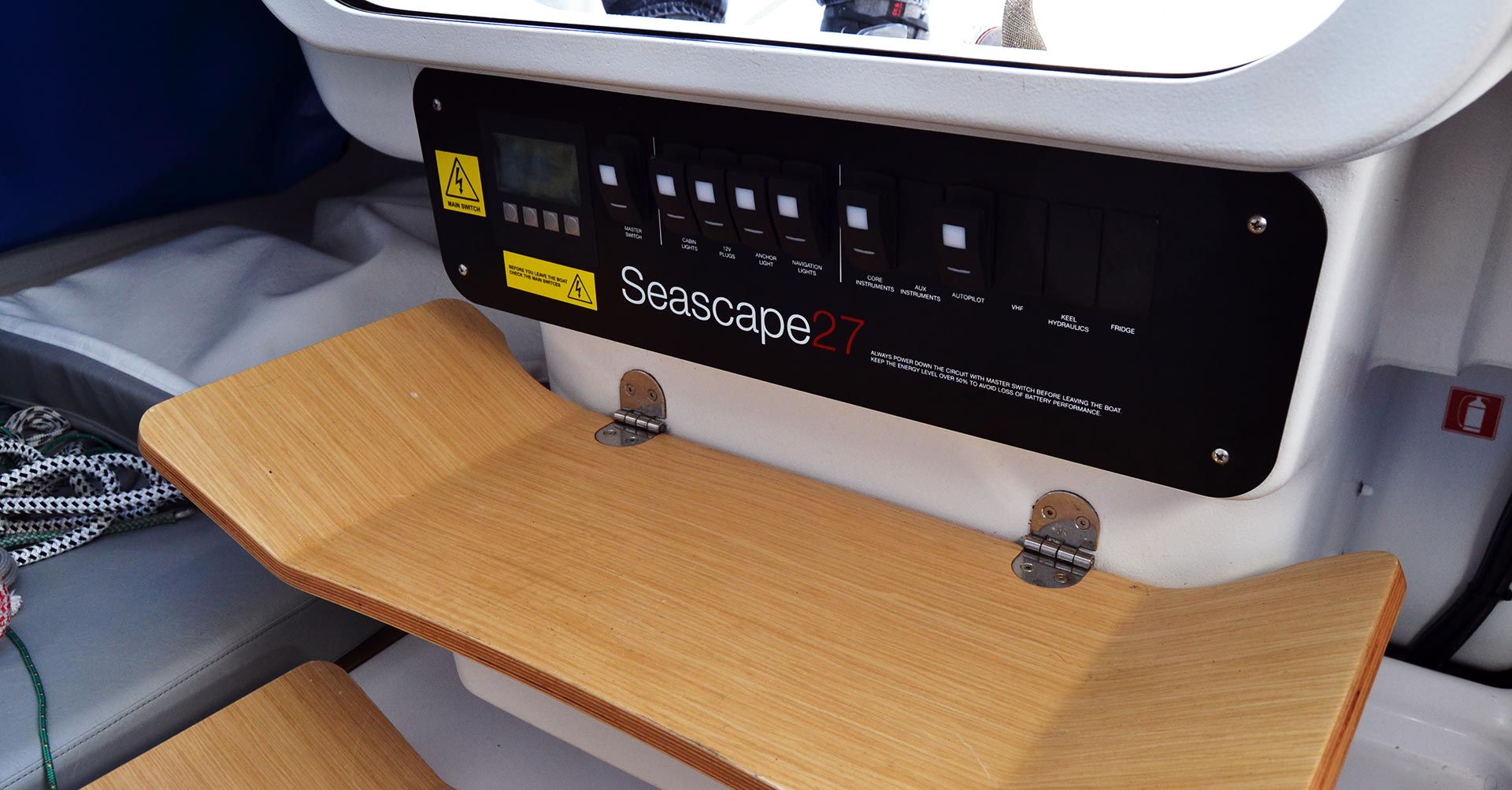
Where to put a proper plotter? Instead of cutting a big hole in the cabin coachroof the Seascape/First 27 features a nice clever rotatable mount where the chart plotter is attached to. The skipper can fold it out and have a look at the charts, upon entering down one may just fold it back. Love it – simple and efficient!
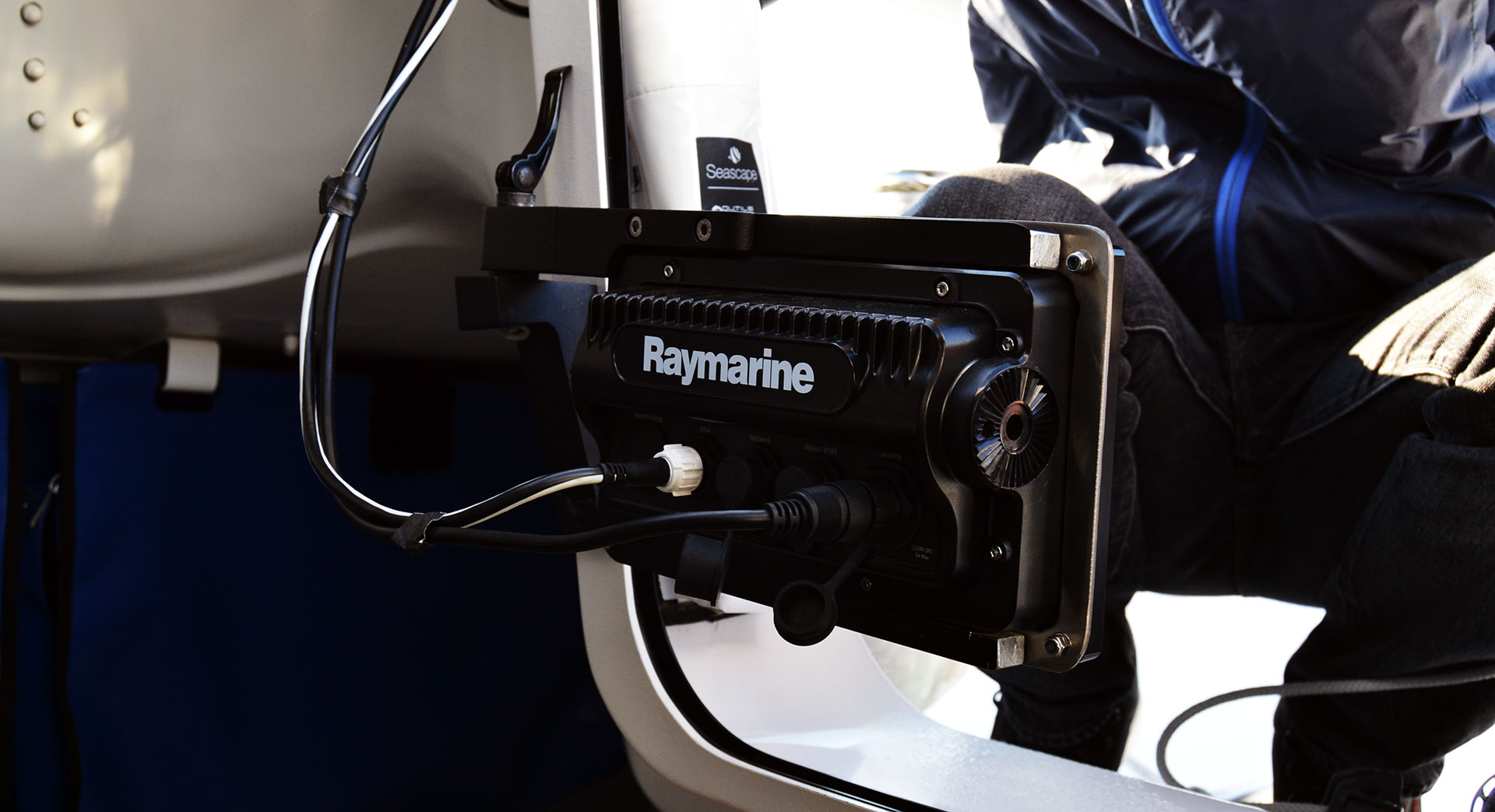
The Seascape/First has a manually operated hydraulic folding keel. The maximum draft of this boat is 2.00 metres. The boat needs this draft, says Tim and points his finger up to the rigging. But later more on this. The keel is pumped up by means of pushing a lever which will operate the hydraulic cylinder. Sounds quite like some work and I was happy not to try it …
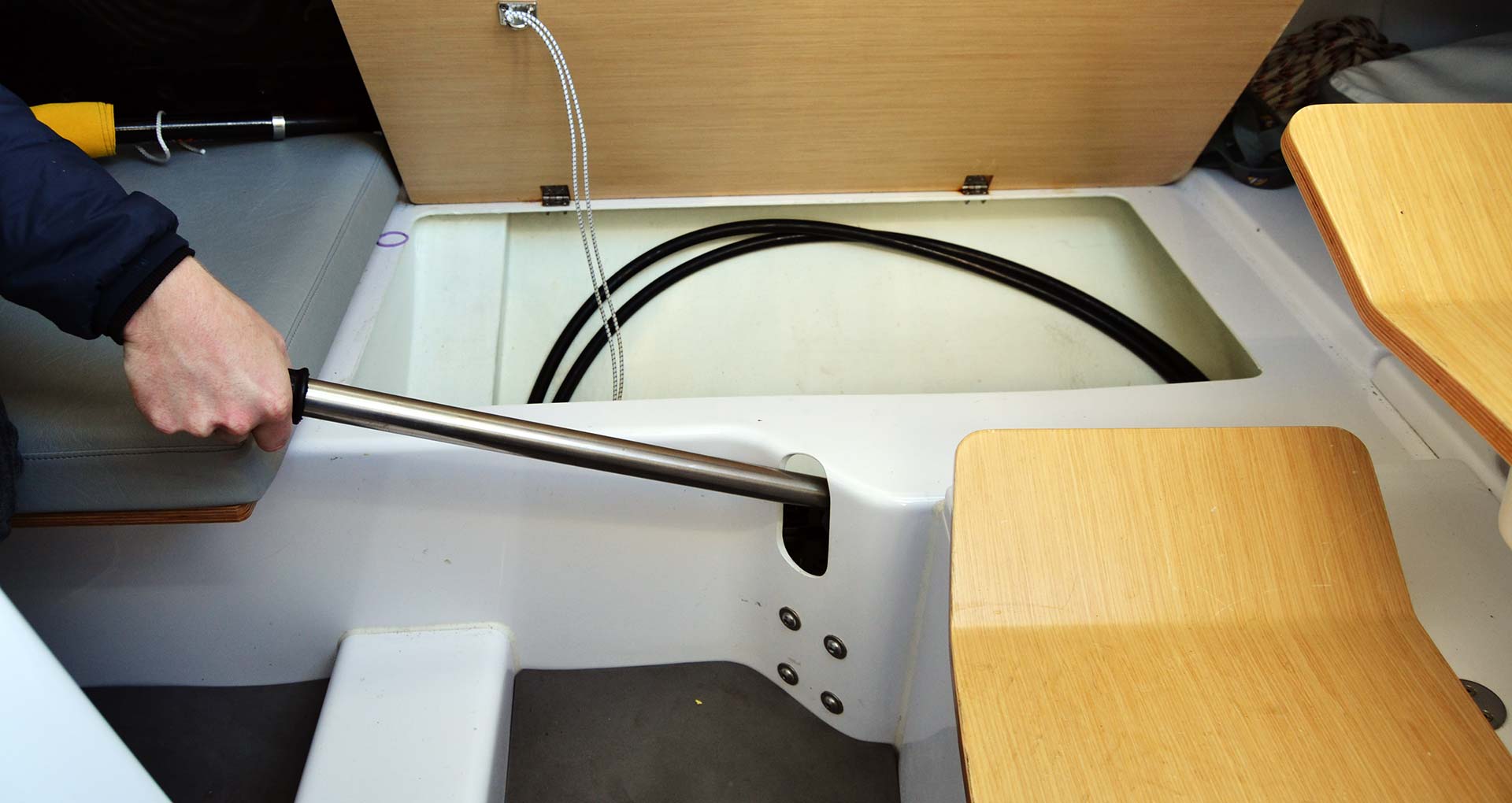
There is some “hidden” stowage underneath every thinkable corner. A smaller compartment under the upper step of the companionway, a larger shelf under the lower. This particular compartment is laid out as a thermos “jug” and can be equipped with a compressor to be operated as a proper fridge. I loved this idea as this 27 feet boat may be used for cruising and longer trips as well. A fridge isn´t the most stupid idea here.
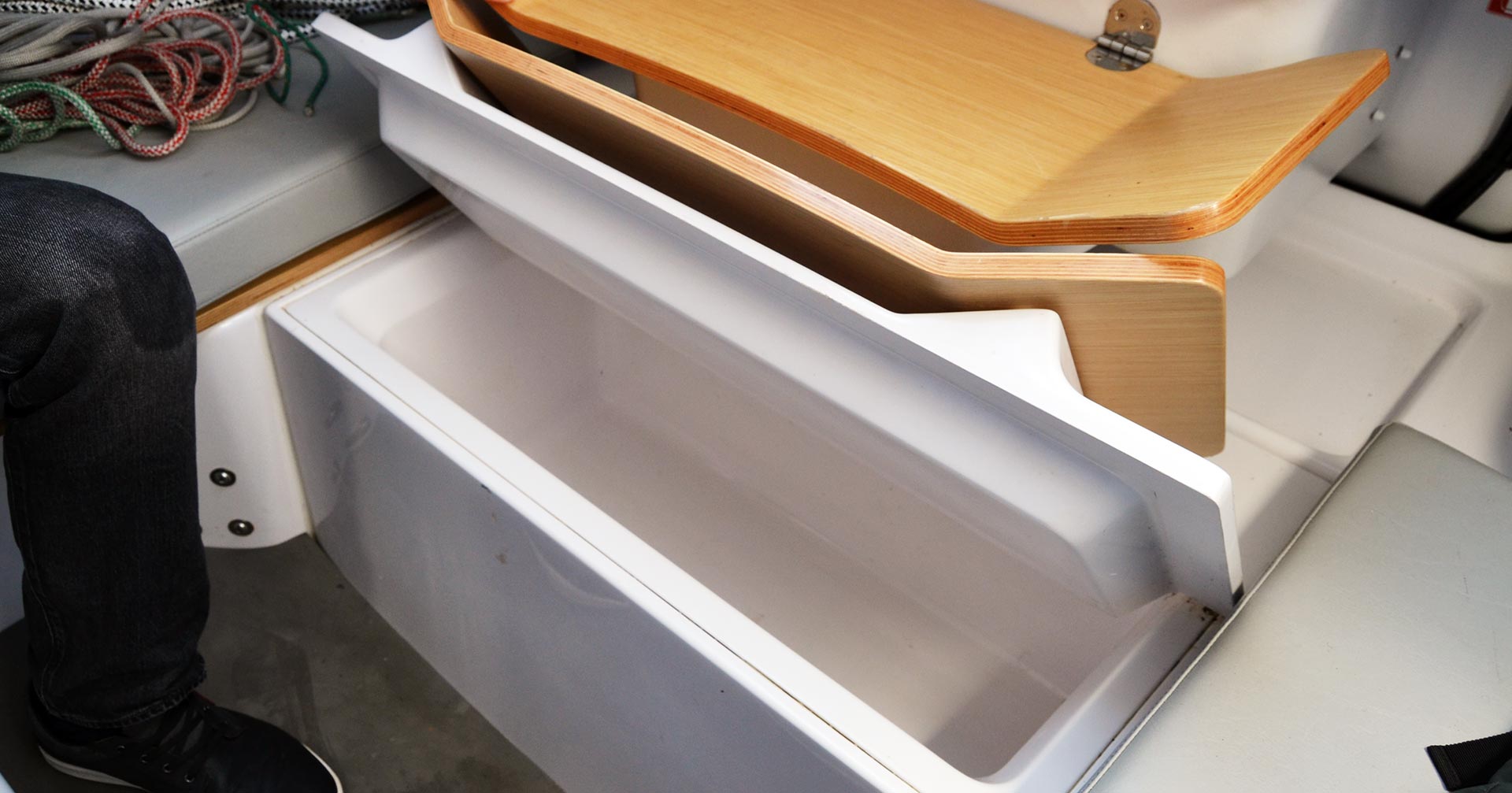
So, all in all, the nice little details signalled that the guys back in Slovenia really pushed the limits and invested a lot of thoughts to create a very fine vessel. I also liked the crew bags which can be taken off the boat and brought home – no more laborious repacking needed. These boats are full of those nice little – simple – gadgets.
Ingenious & spacious
I must admit that I personally fancy the bigger boats. But it was nevertheless interesting to see how the internal volume is used in the Seascape/First 27. Apart from the fact that everything on this 1.200 kilograms of boat is subdued to being light weight and the boat bears the allure of a Pogo, it´s quite spacious though!
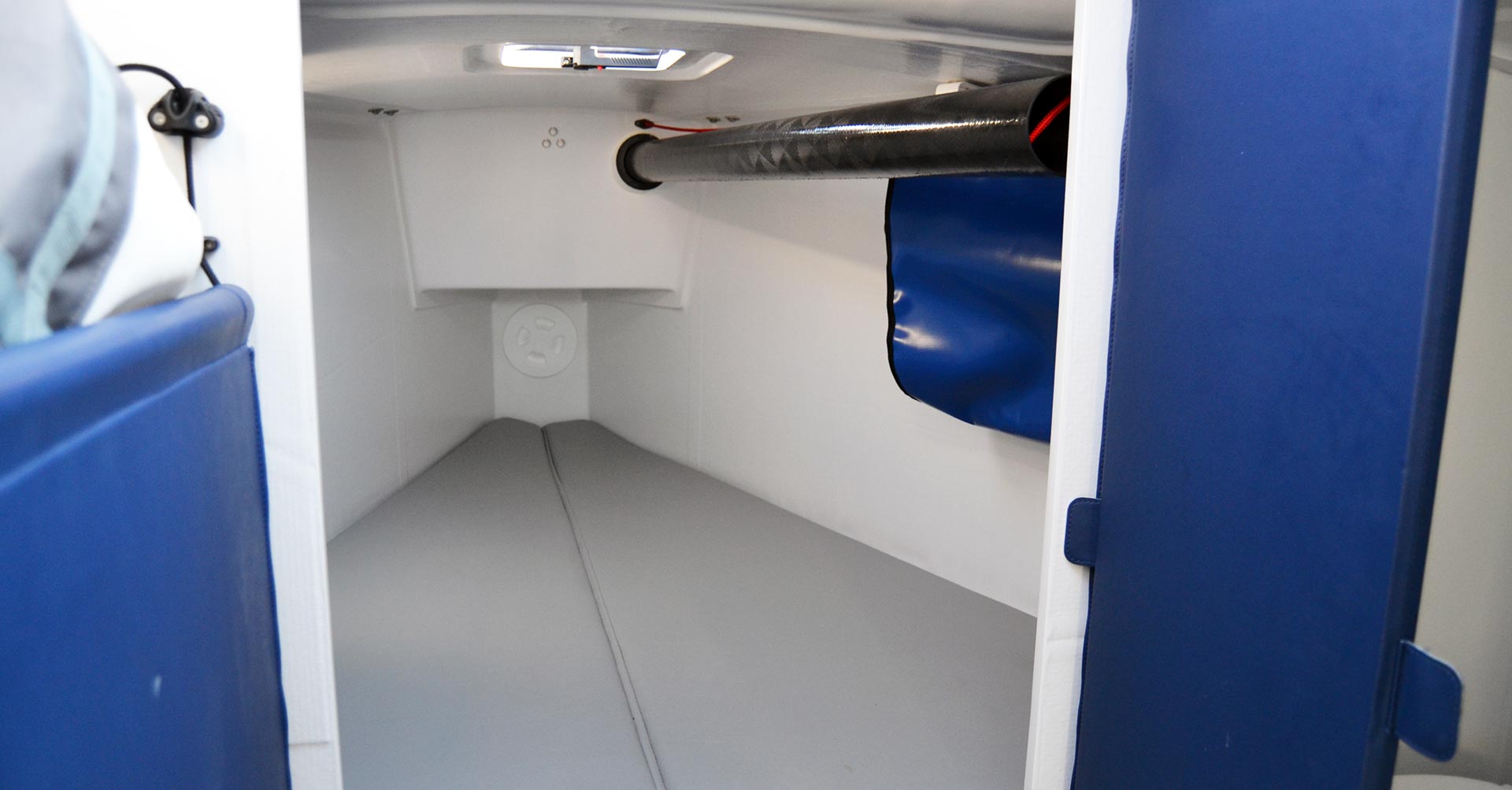
In the salon, two adults can easily stretch out and find a good night´s sleep. They can even bury their feet deep under the cockpit in some tiny “quarter berth”-like bulges. In the fore cabin there is a V-berth that can also serve as means of good night bed for 2 adults although it may be a bit narrow at their feet´s toes where the anchor chain locker is behind the bulkhead.
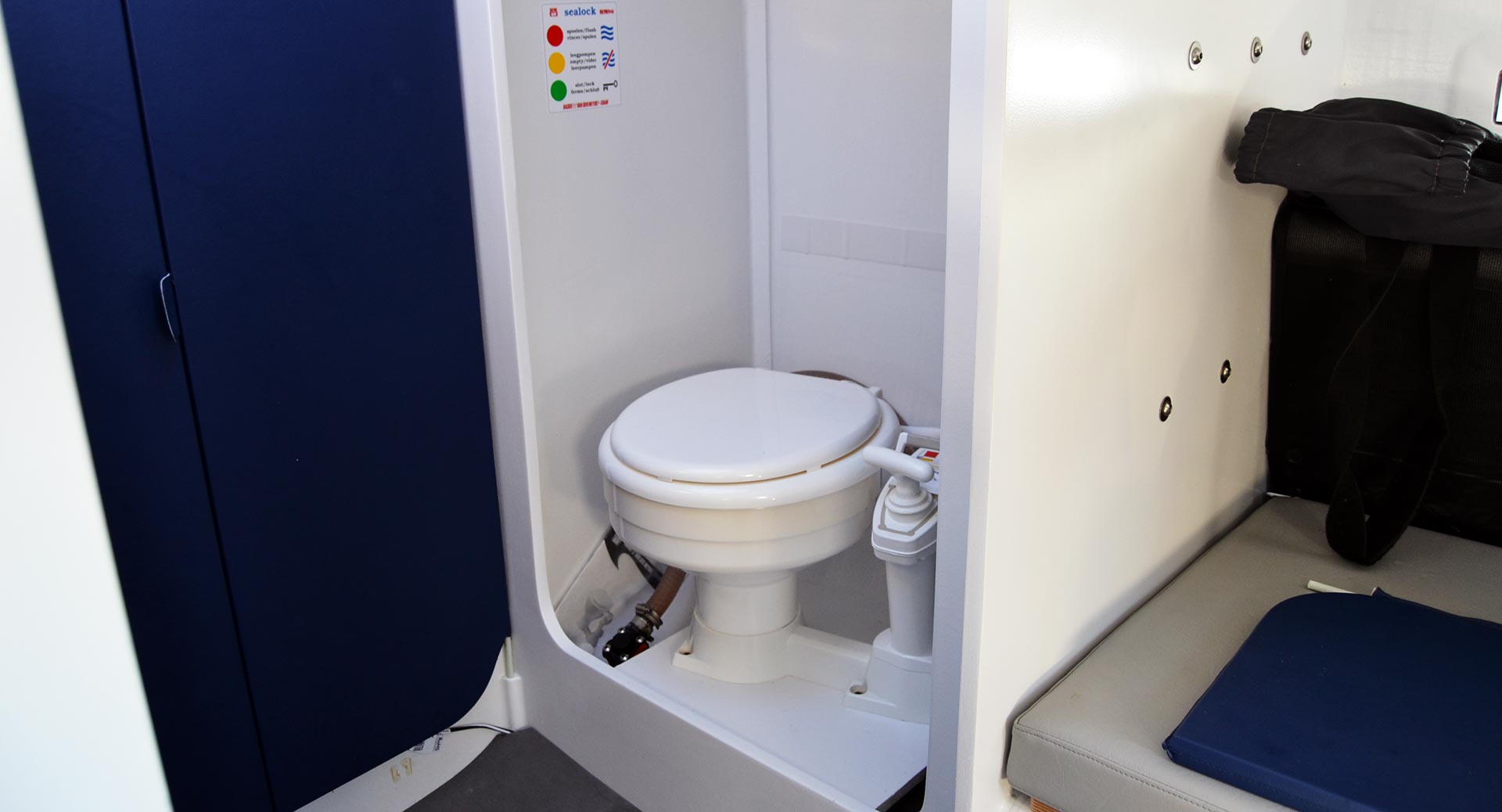
The Seascape/First 27 features a proper toilet that can either be ordered as a pumping toilet with a grey water holding tank (and flushing seacocks) or with a camping-toilet. I fancy the first. What I found really interesting was the magnetic “doors” which may either be used to close the head, close the fore cabin or simply taken off. A very clever detail!
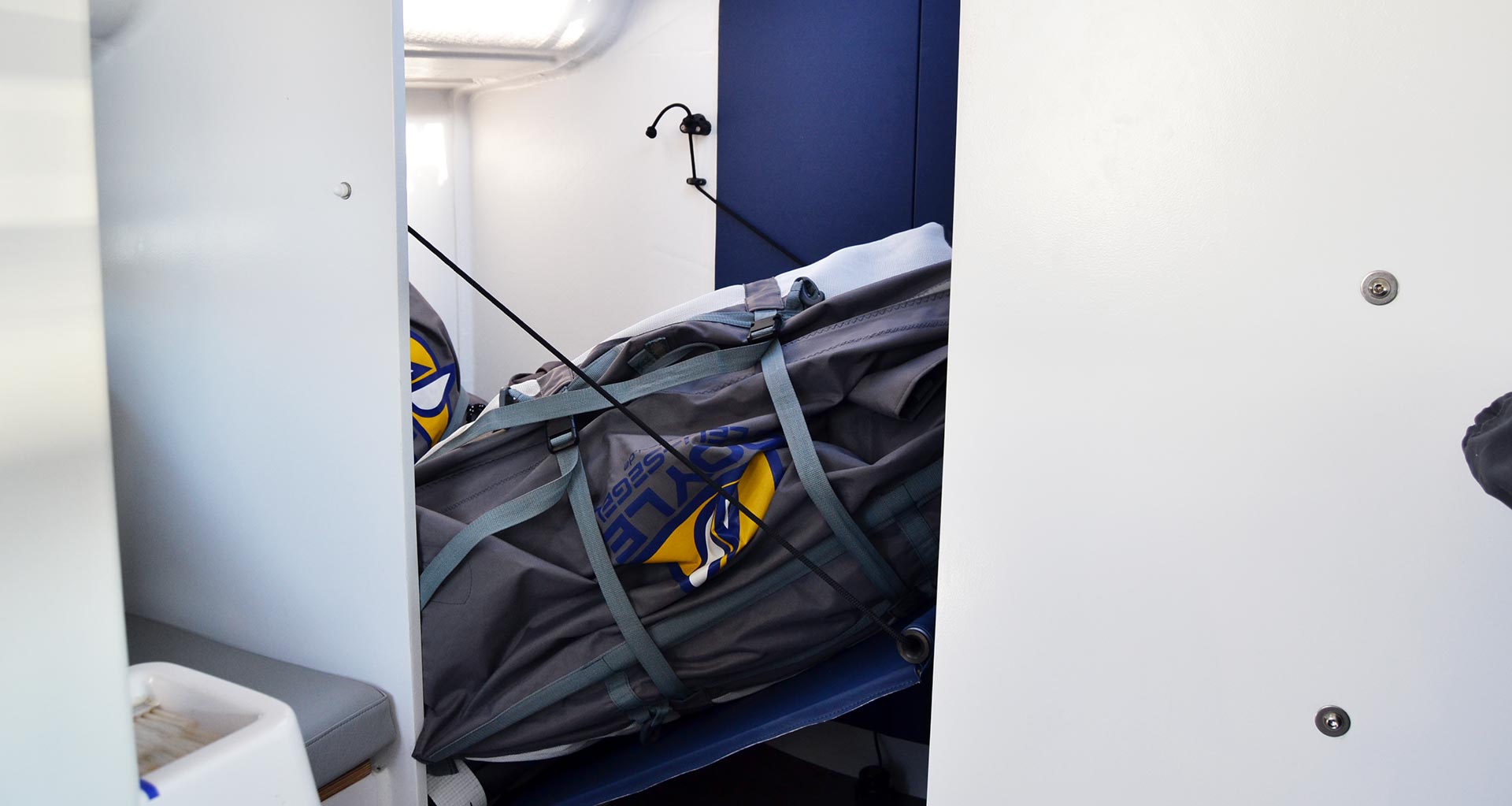
And last but not least, again, very ingenious, the sails locker which is situated vis-à-vis the head. By pulling a string a flap folds out like we know it from our shoe-lockers at home. Now the crew may take out or stuff back in the sails through the hatch in the coachroof. The string may be operated from above as well. I love Seascape/First for these tiny but very thoughthrough details!
Just top of the pops equipment on the First 27
Back on deck Tim was finishing readying the boat and I took a closer look at the equipment of the boat. Our boat featured the Andersen winches, which I love very much, although standard is Harken on the boats. Nevertheless, the Seascape/Firsts come with a very astonishing set of standard features which really surprises me as I am accustomed to very “bare” standard versions in bigger boats because the options is where the money is made with.
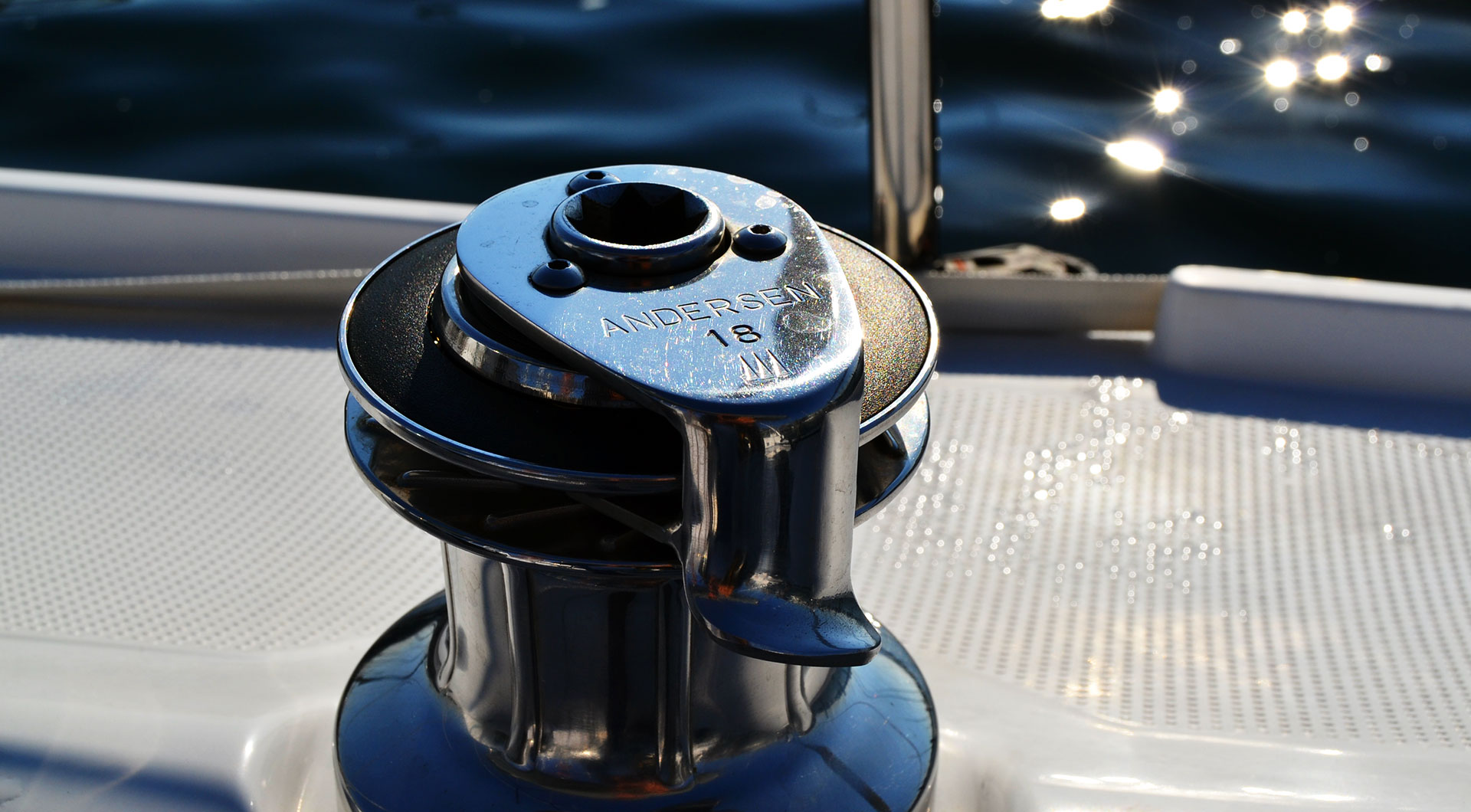
The Seascape/First 27 is made to be sailed and managed by a single sailor. So every clamps and lines are laid back to the cockpit and the small cabin´s roof. And the running rigging is pretty sophisticated, as I will be observing later when we get outside and under sails. The boat is a serious racer and the Seascape/First line sees their adversaries in the J-boats. Out of more than 240 participants of this year´s edition of the Silverrudder race – a single hand non-stop around the Danish island of Fyn – more than 40 boats had been Seascapes!
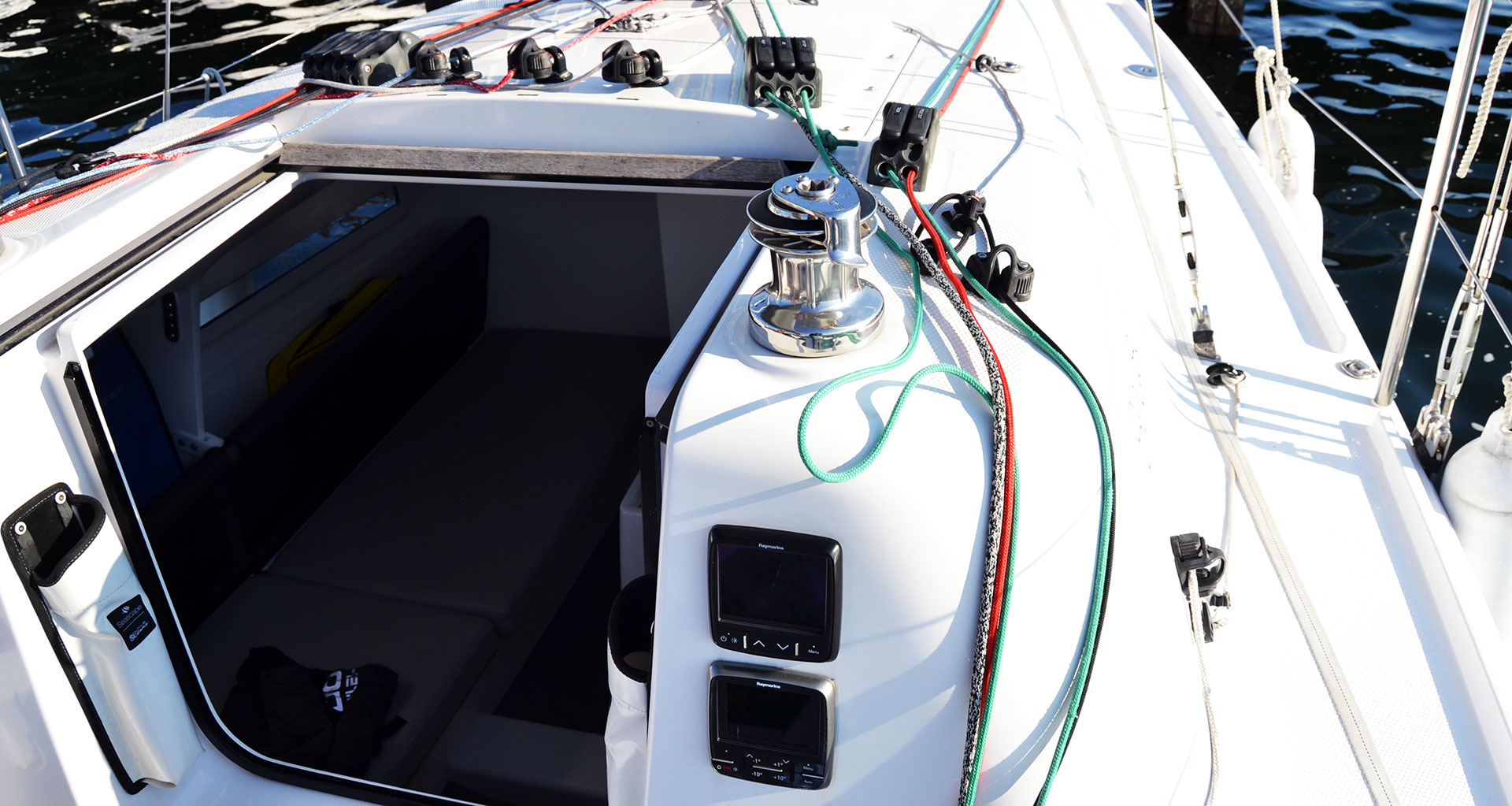
The massive square head mainsail with a stunning sail area of 28 square metres (the J-80 has 21) is hoisted by a 2:1 halyard that is fixed at the masthead, runs down to the nock of the boom and back up. It´s only after that when the halyard comes down again and diverted into the cockpit where the boat´s mainsail may be hoisted. That may take two times the length of a classic halyard but it´s just half the power needed to get sail up.
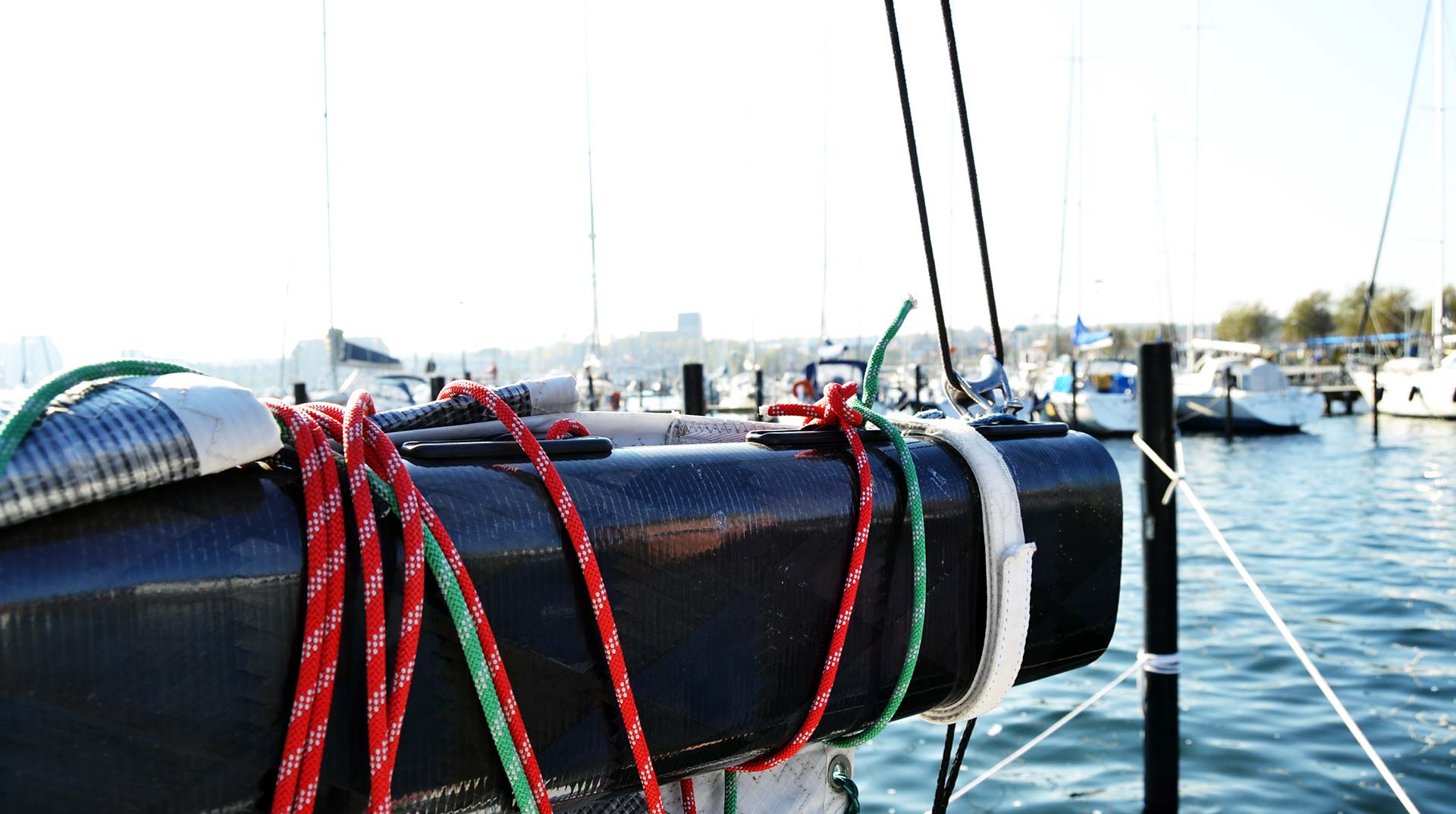
Not standard but a pretty practical optional item on the order list of the Seascape/First 27 was the rodkicker. As the halyard also functions as a toplift as well, the mainsail and the boom will inevitably fall into the cockpit when the sail is taken down. Which is no problem when you sail alone or in a racing mood but can be annoying with friends or guests on board. I love the simple system of the rodkicker mounted on this boat!
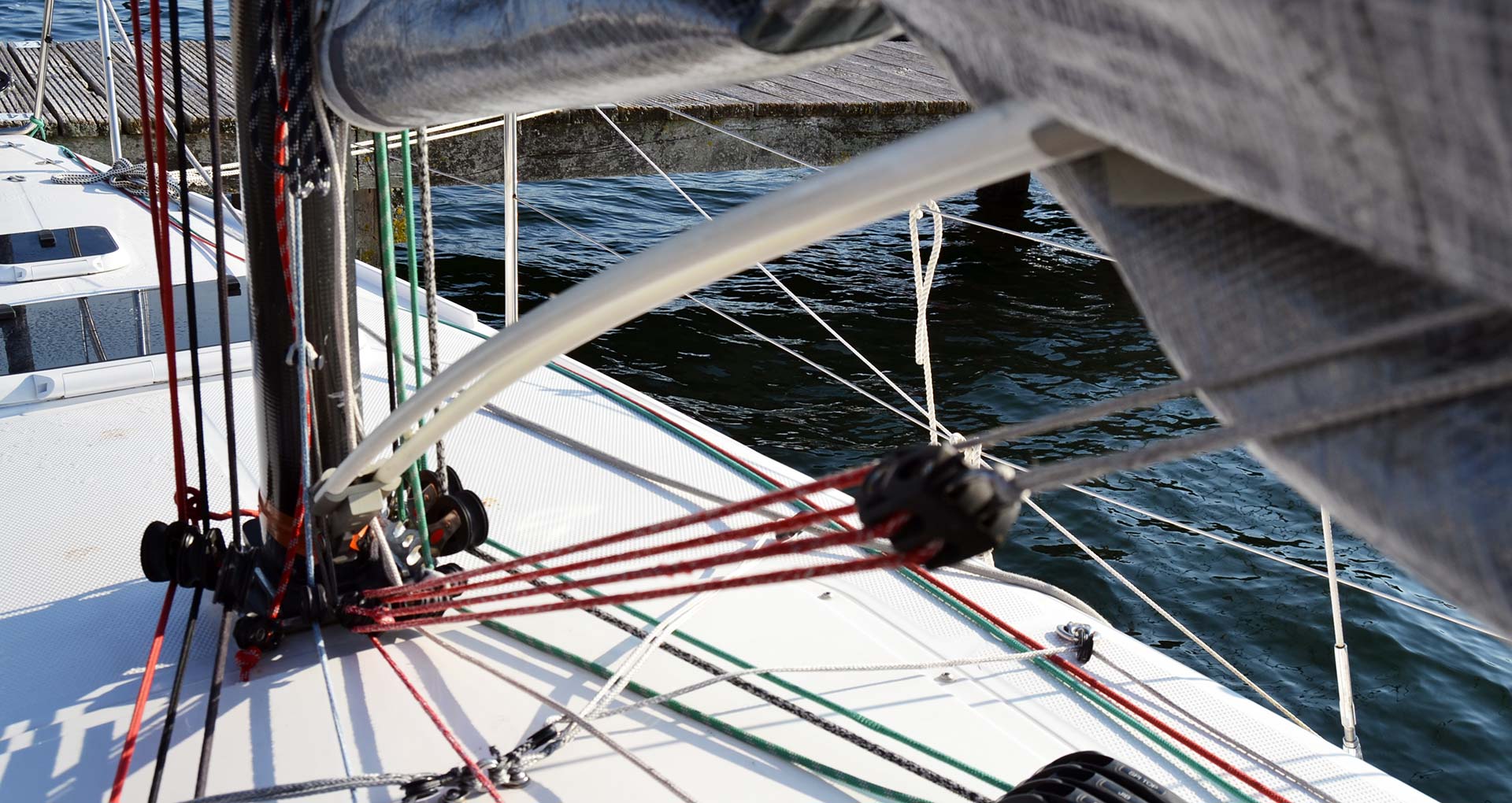
I as well liked the nice details: The tiller is made from carbon, very stiff yet lightweight: I know how pretty damn heavy a massive wooden tiller can turn out to be from my own boat. There is a large mainsheet traveller running the whole lengths from side to side in the cockpit which will allow for fine tuning of the mainsail and even more reassures me that this boat is made to be raced.
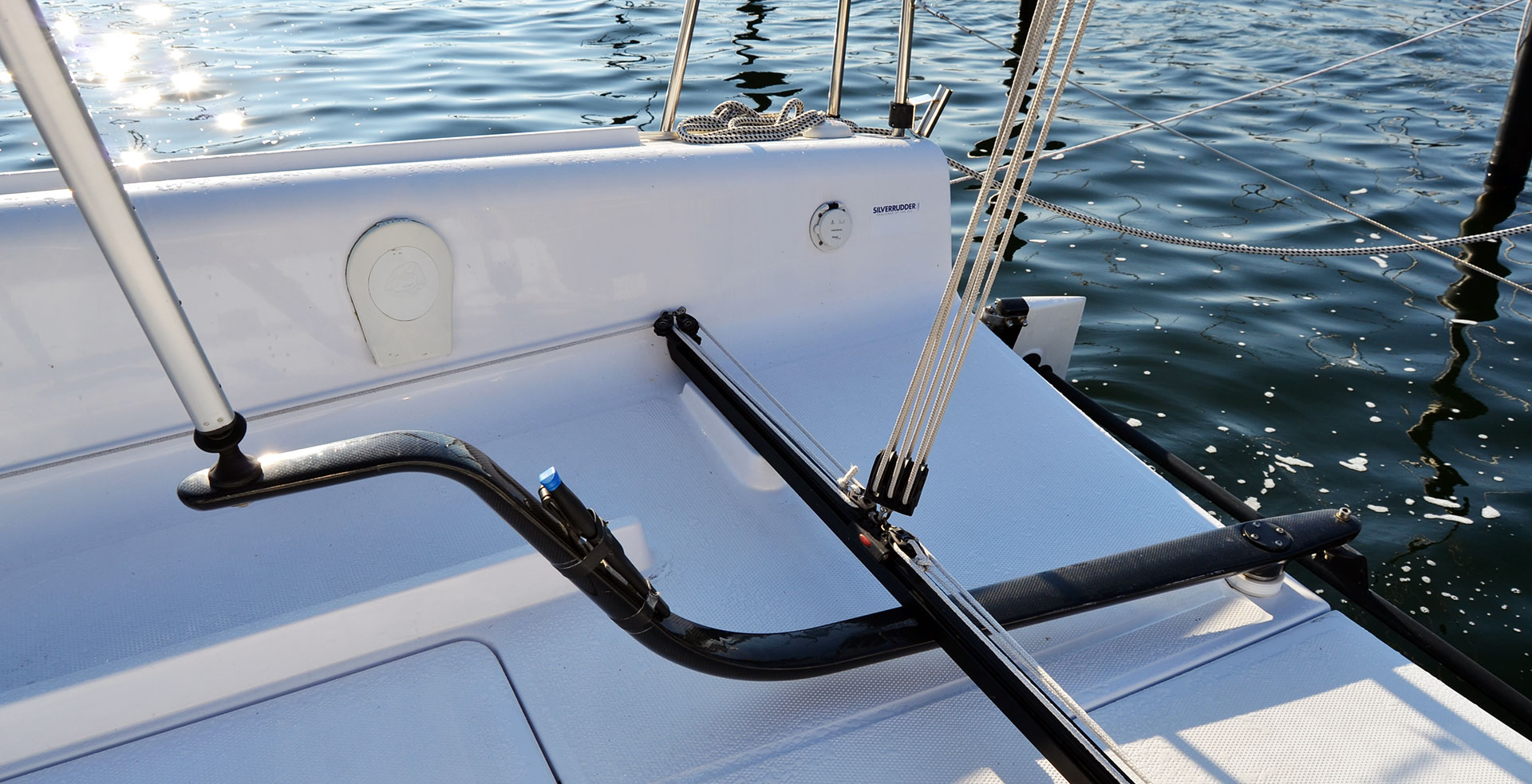
All in all I really got the impression that this boat was also made to be sailed with ease, but I felt an underlying power which was instilled by the complex lines, the racy style of the components and the kind of sexy and mean looks of it all. This was not meant to be a well-tempered cruiser, I guessed. In a way, it turned out that I was right. And in some other way, it didn´t.
Casting off with an inboard-outboarder
We finally got ready to cast off. The Seascape/First 27 can be either equipped with a Tohatsu 10 horsepower outboard engine (which we´ve had aboard) or a Torqueedo electric power engine. What I again found particularly interesting was the “folding” mechanism by which means the engine is rigged to the working position. Tim opens two flooring hatches. The engine is stored lying on one side, strapped to not damage the boat when sailing later and being stowed away.
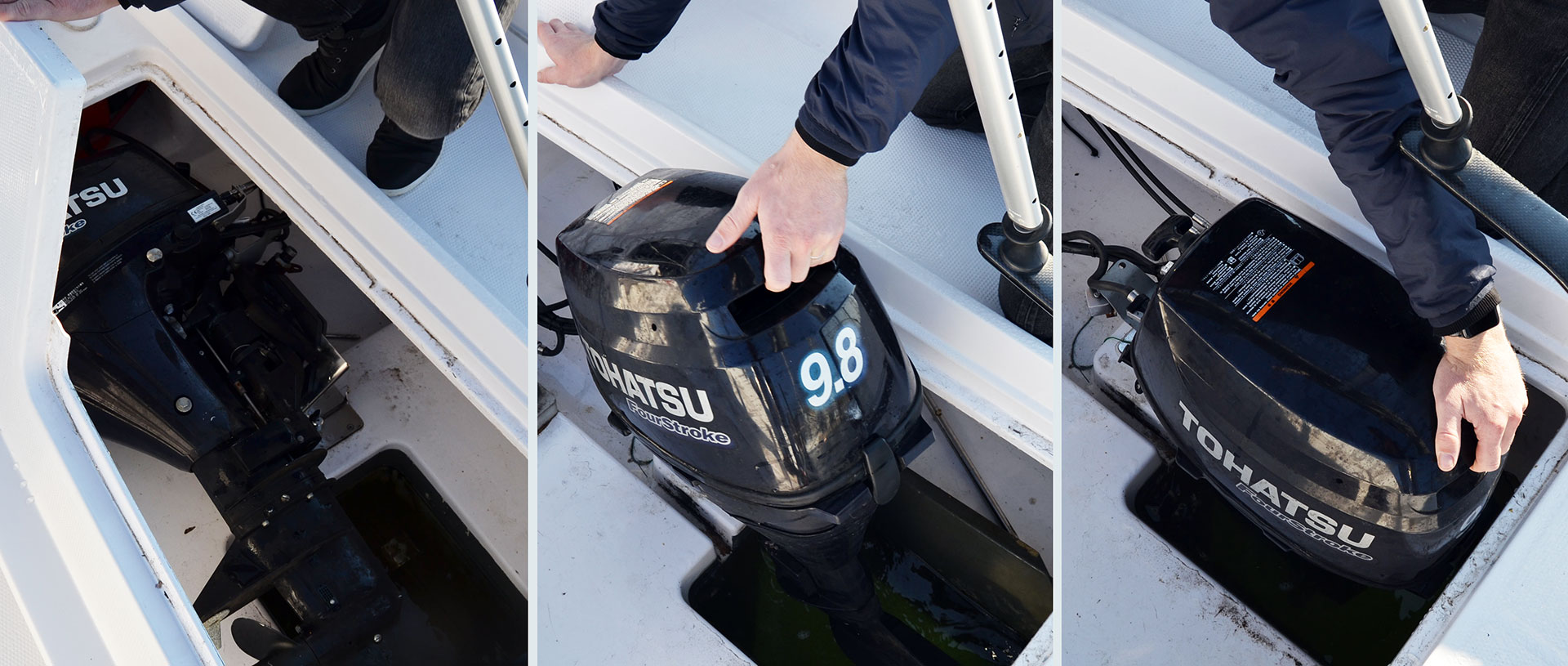
Tim the folds the engine upwards in a way that the screw reaches down to the water. The Seascape/First 27 has a permanent opening in the hull that cannot be closed. There have been experiments to augment a closing mechanism but this turned out to be too complicated and didn´t saved much speed so they simply let it open. Of course, no water will ever reach the inside of the boat …
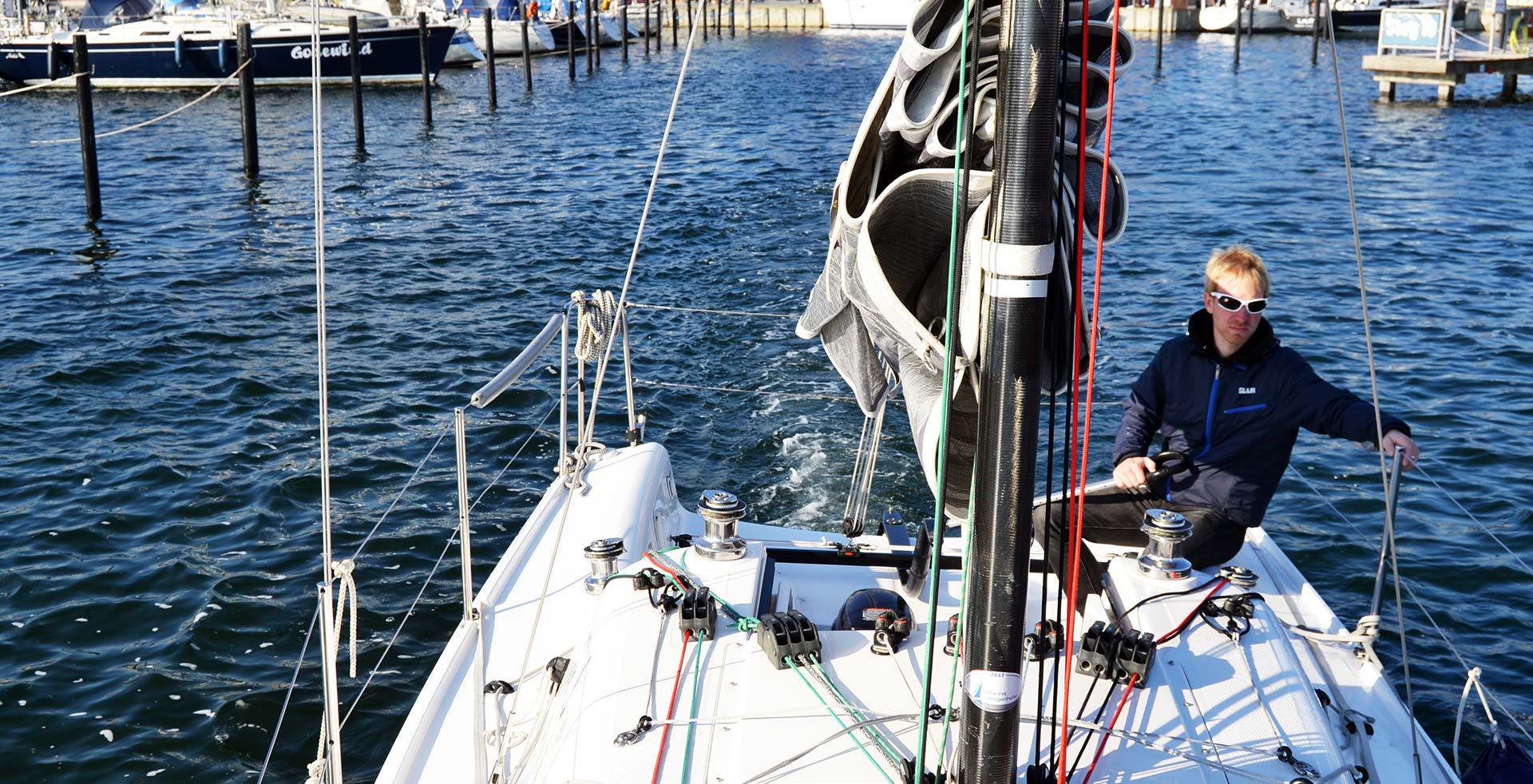
So with quite some nice wind going on we finally dropped the lines and Tim brought us about. We steamed against the wind and I must say the sheer loudness of the engine was terribly annoying! It is always a moment of relief on a sailing boat when the skipper finally turns off the engine, but on the Seascape/First 27 it was a really big sigh of relief from the bottom of our hearts as we had brought enough sea room between us and the marina and Tim finally killed the engine!
Every puff is instant acceleration
Of course not before we held the boat´s bow strictly up wind and he was pulling the halyard to get up the mainsail. I beared away and the boat instantly jumped to speed! With no jib unfurled yet the boat accelerated which I found highly interesting. Tim on the other hand told me, that this was one of the main aspects of the Seascape/First 27 – with a displacement of just 1.400 kilograms all it needs to get it running is a light puff indeed.
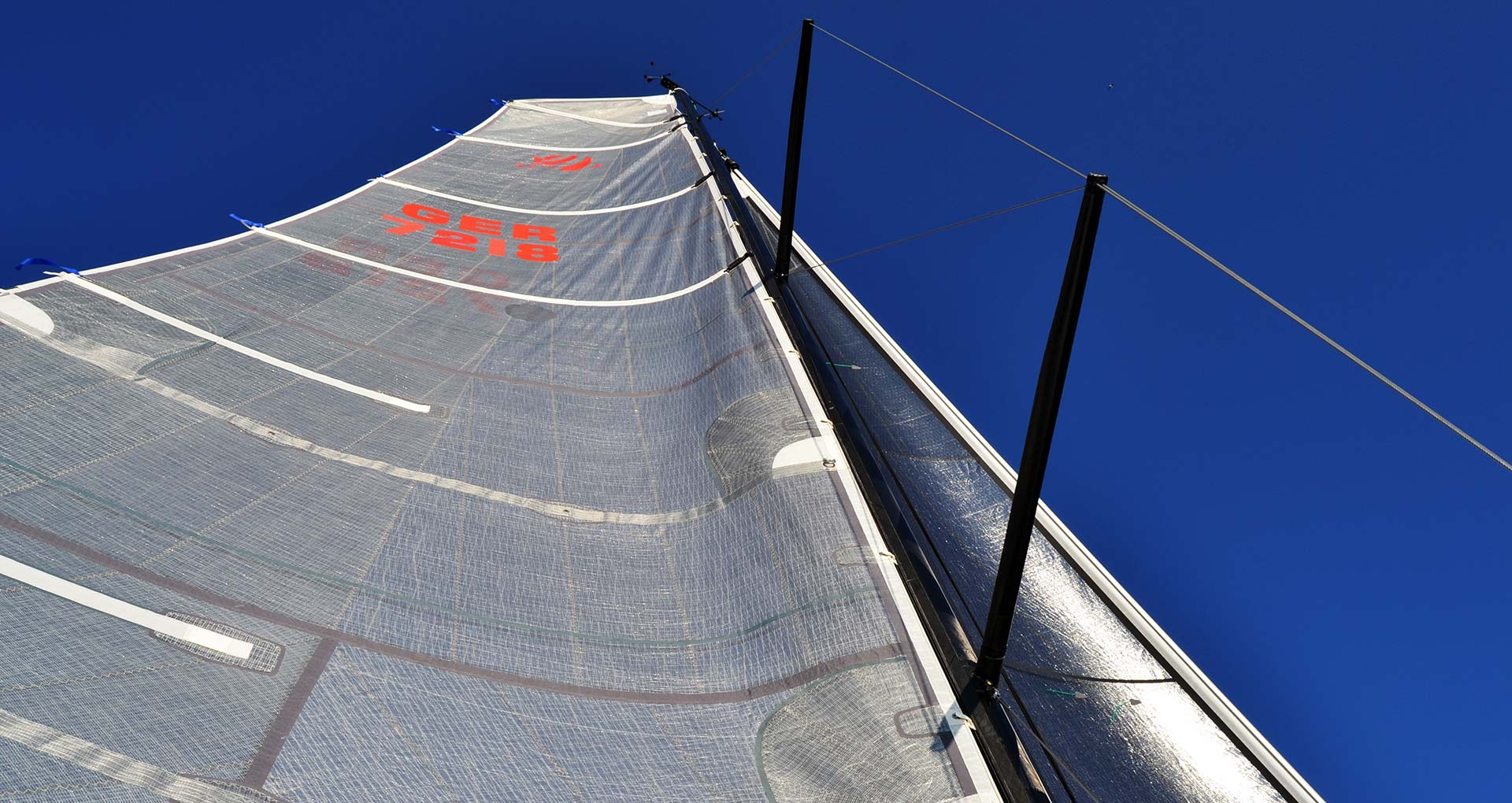
But what a great fun it was to feel her power come to full blossom when the jib was up! We heeled up to a point where the boat gained the stability needed, the windward rudder came completely out of the water and the Seascape/First 27 jumped to life. She was very, very responsive at the helm – thanks to the direct and pure feedback felt in the tiller. The single small blade now submerged was applying instant changes to our course by a finger tip´s movement. Very nice!
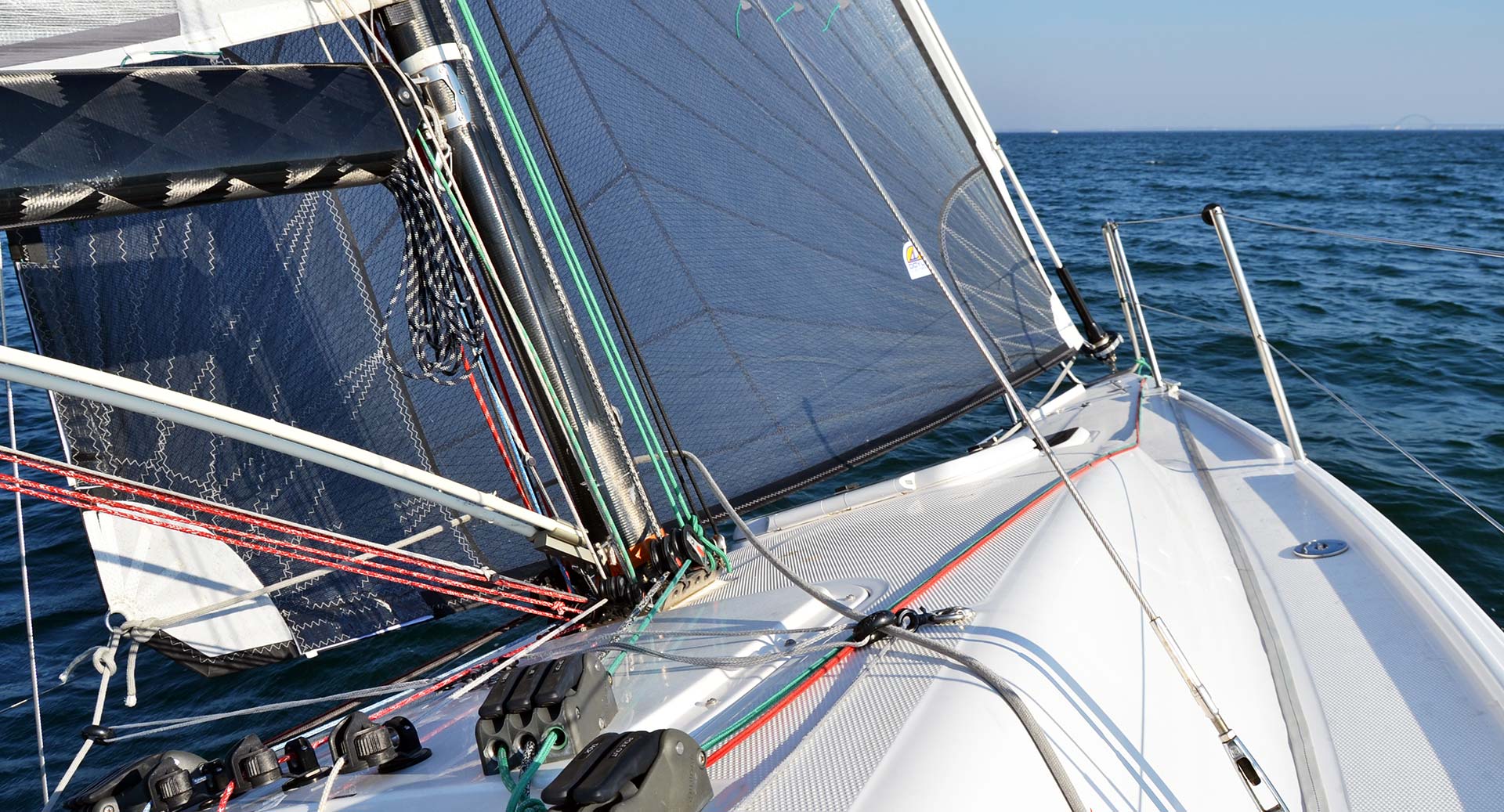
Yes, there was barely any swell going on and I guess that short, choppy waves might cause the boat to feel like a balky stallion – as all small boats do – but these conditions where as perfect as one could wish for. The boat, even when we received a gust, didn´t responded with more heeling but instantly with more speed at first. Only then came the heeling. Brilliant behaviour!
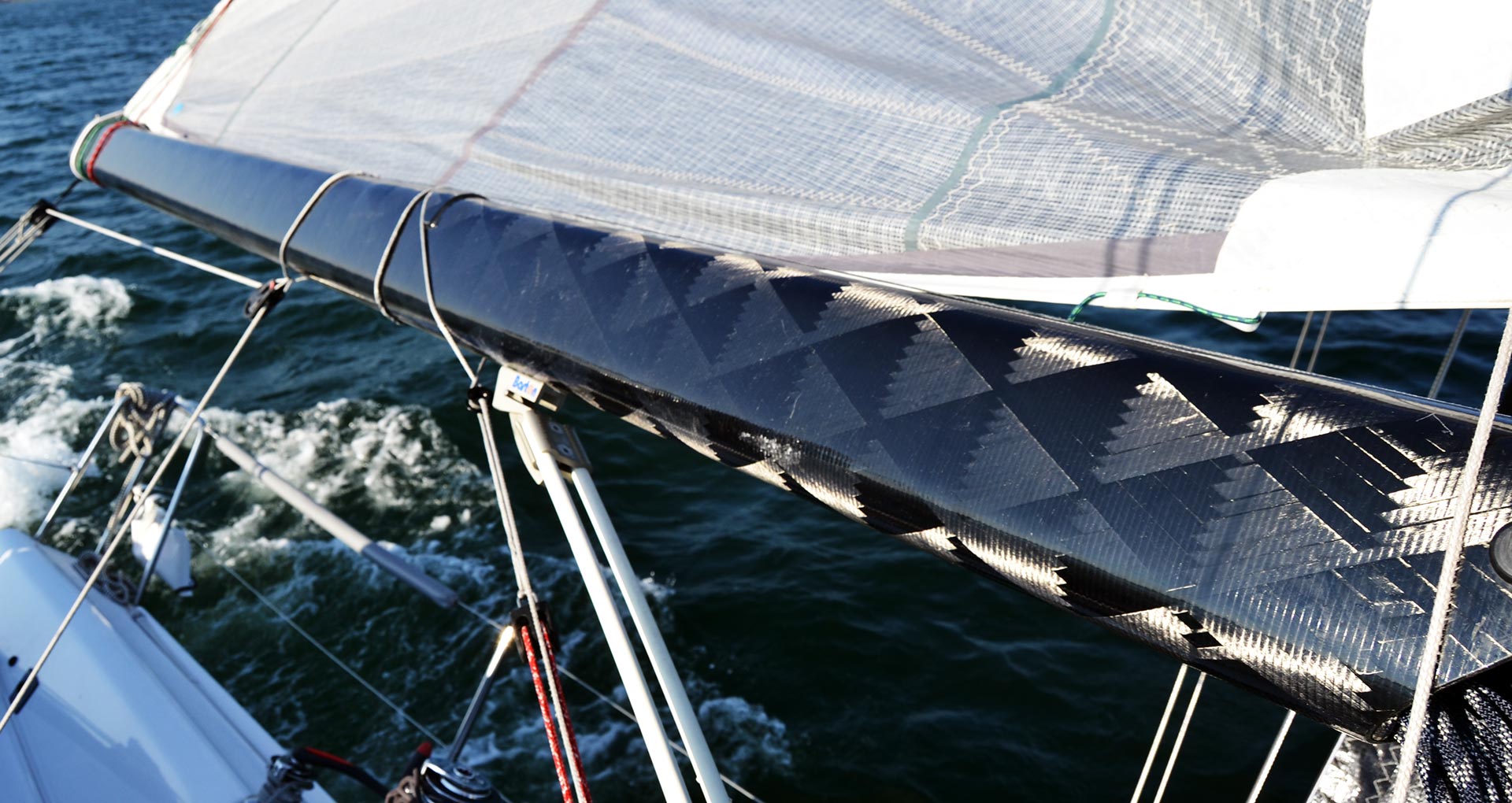
What I also noticed, even when I asked Tim to head up directly into waves to see how she might behave, was that there was no noise at all. No – noise – at – all! No banging, no clinging, no whatsoever. That may indicate a very stiff rigging and a pretty stiff produced hull. I was almost reminded of my sailing trip in an aluminium yacht that was also making no sound at all no matter how hard we bounced into the waves upwind.
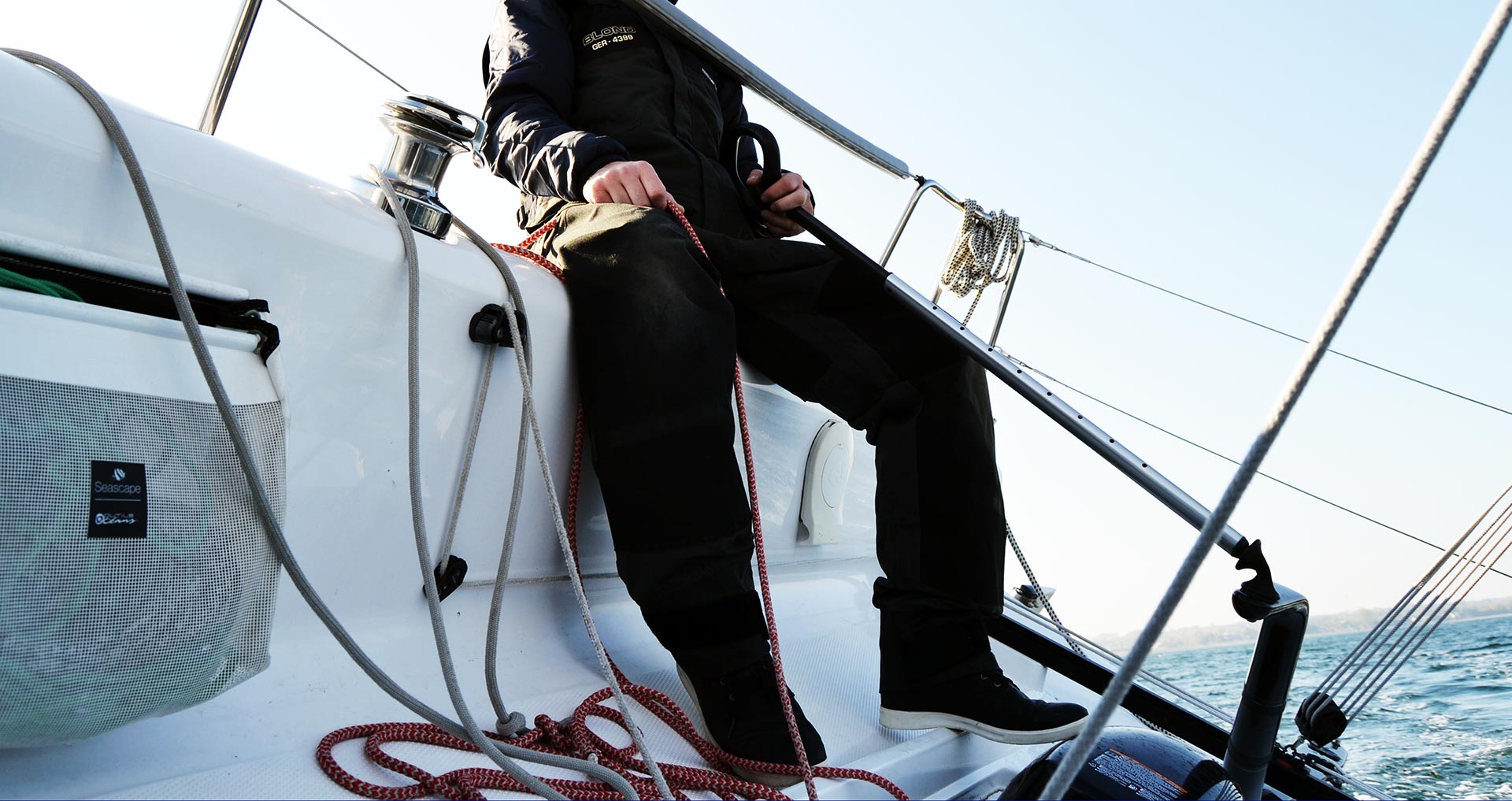
I admired the full carbon mast and boom which both where playing with the sun´s light and exposed their outer fibre-layup. Back in Cannes at the boat show one of the Seascape guys explained to me how elaborately the mast was made and which work went into creating this powerful rigging. And I again wondered why some ordinary production cruisers are making such a noise when sailed …
Fast saling with the Beneteau Seascape-First 27
So, now I got a little more familiar with the boat and we began to thoroughly sailing quite some time on the different points of sail because I was interested in the sailing performance of the Seascape/First 27. Upwind, at some 40 degrees AWA in 10 to 13 knots of true wind the boat, depending on the waves, made some 5 to 6 knots. Until we noticed that we had forgot to take in the engine. Tim said that it would cost around half a knot letting the prop out. And we did so.
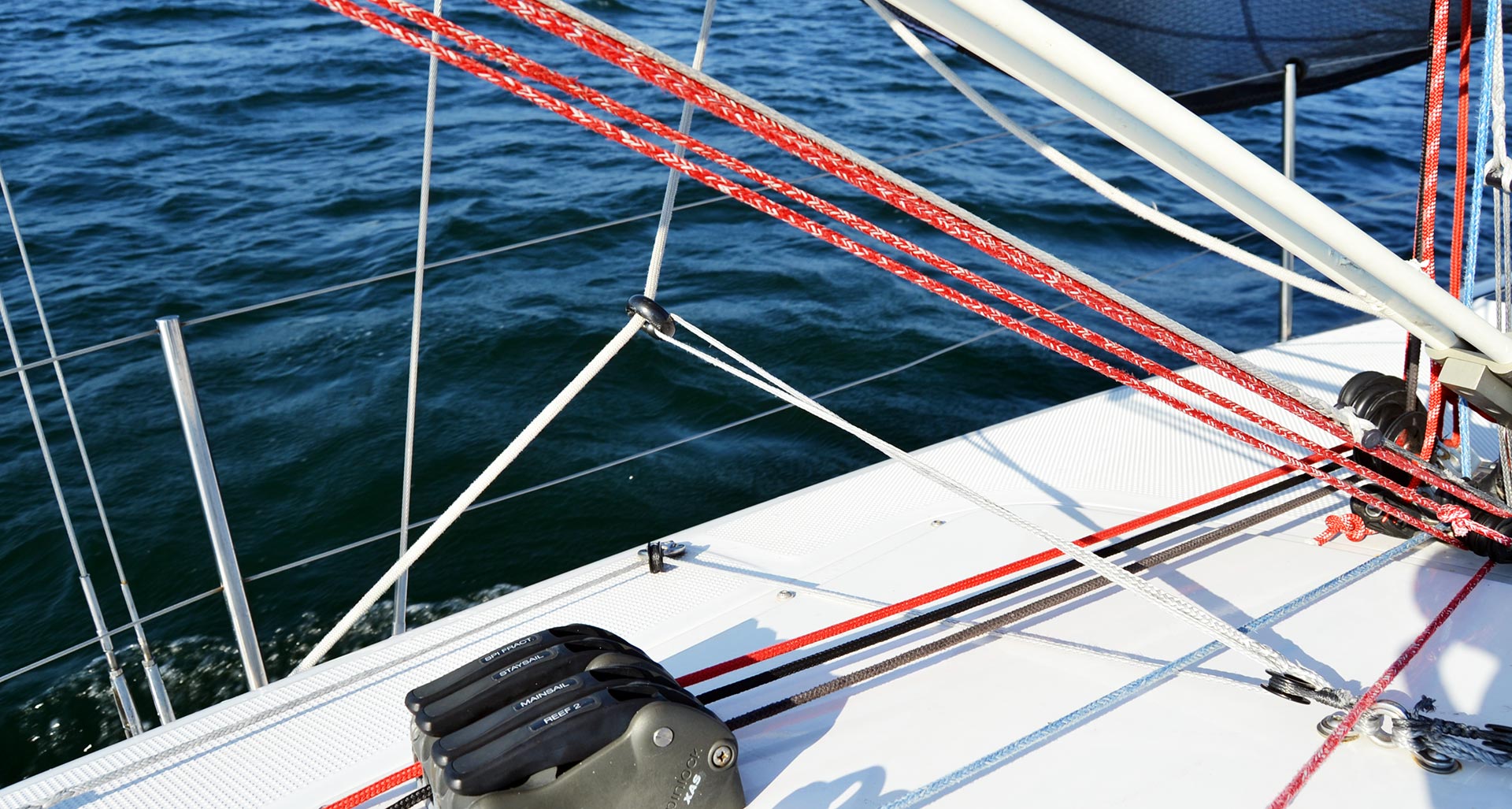
The boat´s jib can be fine tuned with 3D sheet leads which is something I find highly interesting. Although some cruiser-sailors might find this too much of trimming possibilities, I think this is quite fancy on a racing boat like this. I fiddled around with these and could instantly see what my actions changed (mostly not for better performance …).
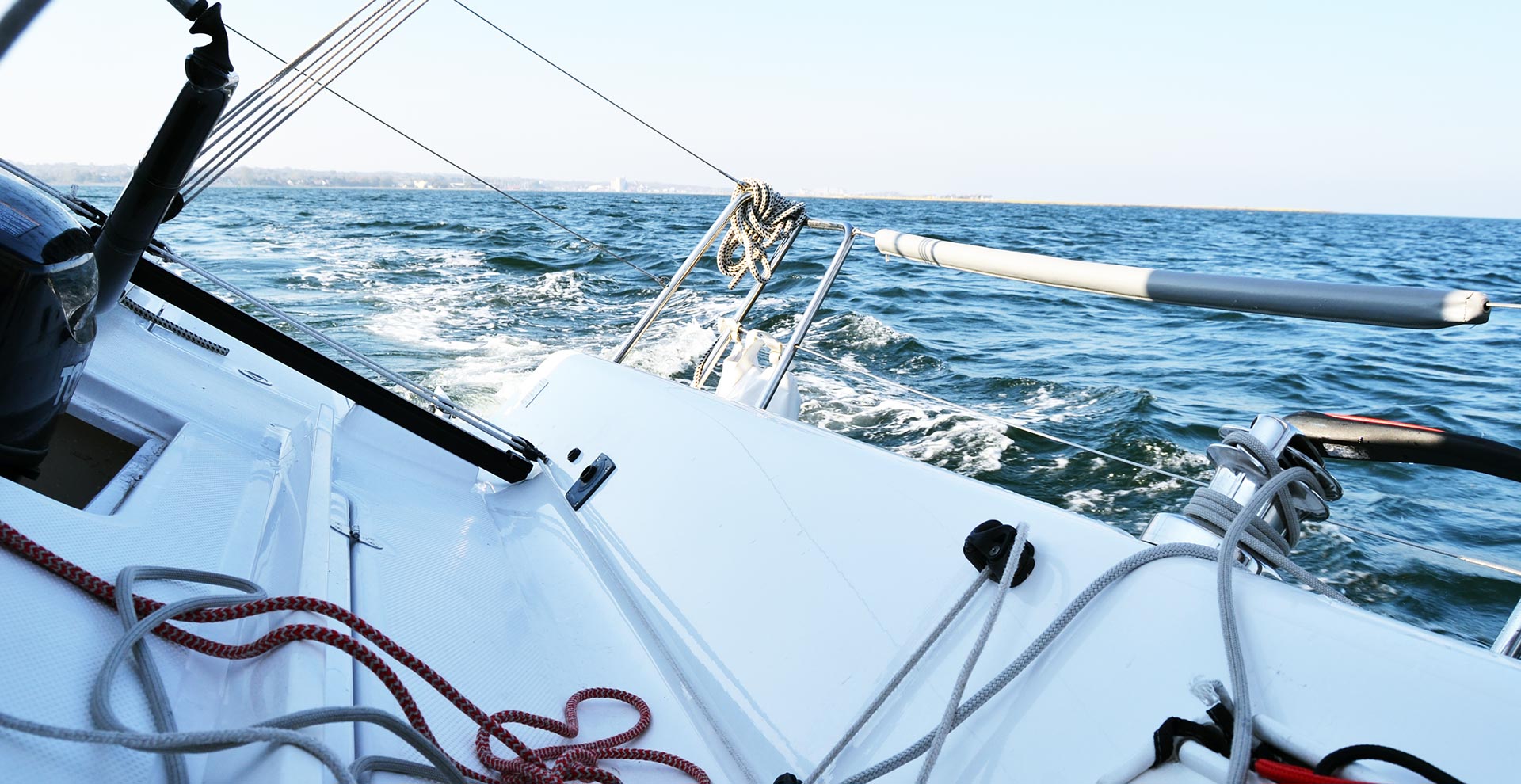
We then beared away to a nice beam reach and tried this on both starboard and port tack. With again winds ranging from 10 to 13 knots true and the AWA ranging from 80 to 100 degrees the Seascape/First 27 managed to speed up to 7 – 7.4 knots SOG easily. Remember, we´ve still had the engine down with the prop spinning, singing a high-pitched tone. A nice audio indicator by the way.

We then beared away further to an AWA of 120 to 140 degrees. The Seascape/First 27 was making 7.6 to 7.9 knots over ground and it was great fun. Tim assured me that this was nothing compared to the real potential that was in her: Perfect conditions for a Gennaker! When we finally were flat running before the wind, surprisingly, when I furled away the job the boat didn´t much slowed down. Still 7.1 knots with just the main up. Wow.

Back in harbour we moored the boat and now she wasn´t appearing so small at last. The Seascape/First 27 is a fun boat to sail, she may be a beast when ridden properly and a serious contender on inshore as well as on coastal regattas. She may also be sailed as a cruiser and can offer quite some amenities to a young couple destined to have the sailing adventures of their lives. Good job, Seascape! And also: Good job Beneteau – the new breed of First yachts couldn´t have got a better predecessor to be derived from than these tough boats!
Thanks to Doyle-O´Leu sailmakers and Tim in particular!
You like the smaller fun boats? This may be of interest for you:
Sailing the Beneteau First 30 R in foul weather
Mini-Transat with Lizzy Foreman
Building a Mini racer from plywood
